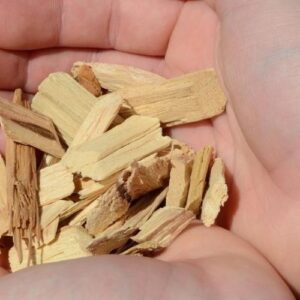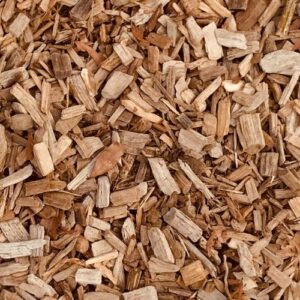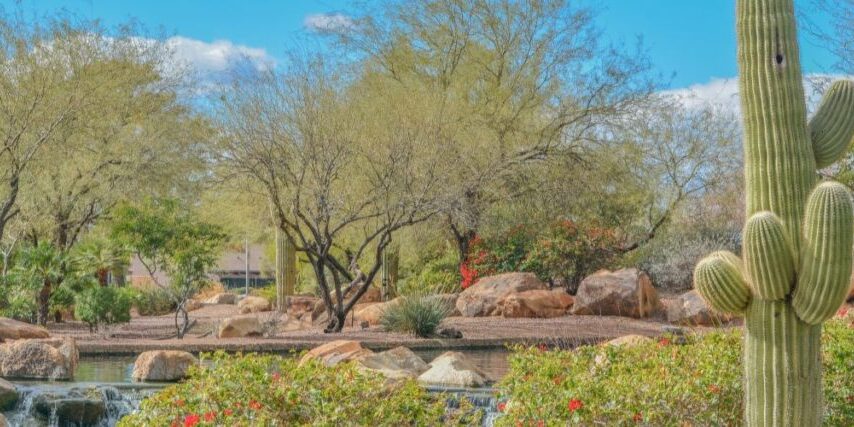
With Arizona experiencing drought conditions statewide and the 4th driest period on record, North Phoenix homeowners are witnessing firsthand how challenging our desert environment can be for plants. Yet, drive through neighborhoods like Anthem, Scottsdale, or Paradise Valley, and you’ll see stunning landscapes where desert plants not only survive but thrive in conditions that would kill most other vegetation.
The secret lies in understanding both the remarkable survival mechanisms these plants have evolved and how proper care can support their natural resilience.
Key Takeaways
- Desert plants use three main survival strategies: water storage in specialized tissues, extensive root systems that maximize water collection, and protective features that minimize water loss.
- Deep, infrequent watering (reaching 2-3 feet deep for trees) is more effective than frequent shallow watering for supporting desert plant health.
- Native plants, like palo verde and mesquite, have adapted root systems that extend 2-3 times wider than their canopy to capture rainfall.
- Proper watering timing (early morning between 4-6 AM) prevents water loss and reduces stress during North Phoenix’s extreme heat.
- Understanding plant adaptations helps homeowners make better care decisions and choose appropriate species for neighborhoods like Cave Creek and Desert Hills.
- Professional plant health assessments can identify specific watering needs based on your North Phoenix property’s unique conditions.
How Desert Plants Survive: The Science Behind Their Harsh Condition Adaptations
Desert plants have spent millions of years perfecting survival strategies that seem almost impossible. In an environment where temperatures soar above 115°F and rainfall averages less than 8 inches annually, these remarkable plants have developed adaptations that allow them to not just survive, but flourish.
Water Storage Adaptations
The most visible adaptation is succulence – the ability to store water in specialized tissues. Cacti, like the iconic saguaro, can store up to 5,000 liters of water in their expandable stems. These stems have accordion-like pleats that expand after rainfall, creating living water tanks.
Meanwhile, agaves store water in their thick, fleshy leaves, while desert trees, like the palo verde, store moisture in their green bark, which actually performs photosynthesis.
And the waxy coating you see on many desert plants? That serves as nature’s waterproofing. This cuticle prevents water from evaporating through the plant’s surface, much like how a protective coating keeps moisture from escaping a swimming pool.
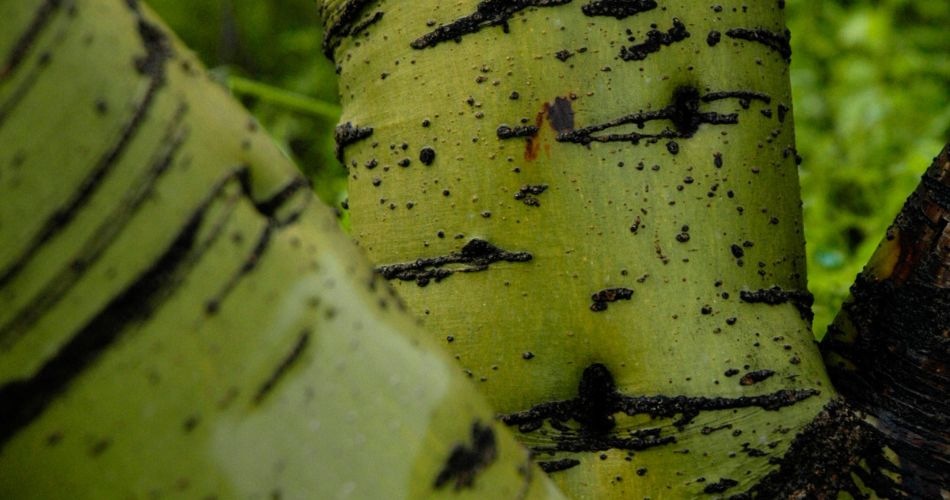
The distinctive green bark of palo verde trees performs photosynthesis, demonstrating one of the remarkable adaptations that allow desert plants to thrive in harsh conditions.
Root System Strategies
What you can’t see underground is equally impressive. Desert plants employ two main root strategies: shallow, widespread systems that quickly capture rainfall, and deep taproots that access groundwater. A mature mesquite tree’s roots can extend 100 feet from the trunk and reach depths of 80 feet underground.
The saguaro cactus demonstrates the shallow approach perfectly; its roots spread horizontally as far as the plant is tall but stay within the top four inches of soil. This design allows the plant to quickly absorb water from brief desert rains before it evaporates.
Protective Mechanisms
Spines aren’t just for protection from animals – they also create microclimates around the plant. These structures shade the plant surface and create small pockets of humid air that reduce water loss. Some plants, like brittlebush, have reflective, silver-colored leaves that bounce away harsh sunlight, keeping internal temperatures cooler.
PRO TIP: “After 25 years working with desert plants throughout North Phoenix, I’m still amazed by their resilience. But even the most drought-tolerant plants benefit from understanding their natural systems and supporting them with proper care,” says our lead Certified Arborist at Titan Tree Care.
Signs Your Desert Plants Need Water
Desert plants are excellent communicators if you know what to look for. Here are key warning signs:
- Leaf Wilting (beyond normal): Slight wilting during the hottest part of the day is normal, but wilting that persists into evening indicates water stress.
- Leaf Changes: Leaf drop, yellowing, or browning edges often signal either too little water or, surprisingly, too much water.
- Succulent Appearance Changes: Succulents will begin to shrivel or appear deflated when they need water.
- Texture Changes: Succulent leaves may lose their normal plump appearance and feel soft to the touch when dehydrated.
- Soil Dryness: Probe the soil to check moisture levels at the root zone depth (1-3 feet depending on plant size).
How to Water Desert Plants in Extreme Heat and Drought
Understanding how desert plants work helps explain why proper watering is so different from what many homeowners expect. Recent research on tree mortality across our region shows that most plant problems stem from watering too frequently and too shallowly rather than not watering enough.
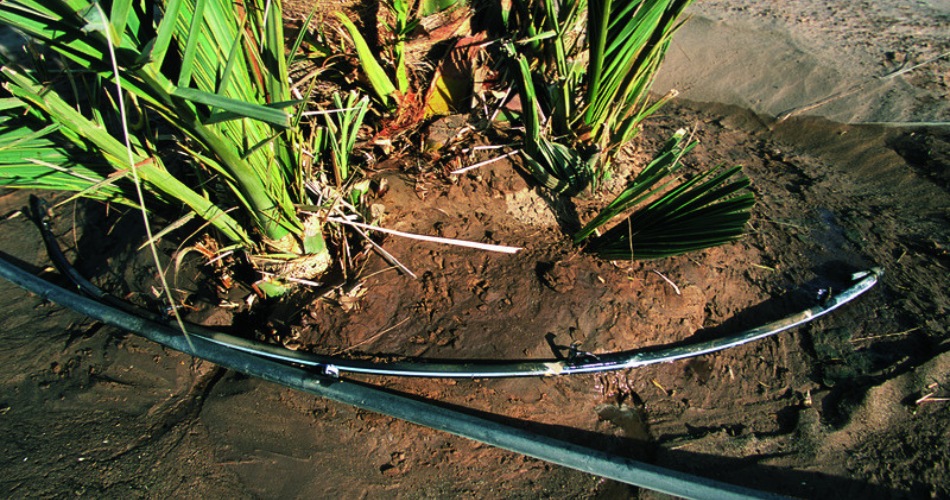
Deep Root Watering
The key principle is “low, slow, and deep.” Water should penetrate to where the plant’s feeder roots actually live – typically 2-3 feet deep for trees and shrubs, and 1 foot deep for smaller plants and ground covers. You can test water penetration by probing the soil with a piece of rebar (steel reinforcing rod), a long screwdriver, or a wooden dowel rod after watering.
For established trees throughout the North Phoenix region, water should be applied at the drip line (the outer edge of the canopy) rather than near the trunk. As plants mature, move your irrigation emitters outward to follow the expanding root zone.
Timing and Frequency Guidelines
The best time to water is early morning, between 4:00 and 6:00 AM, before temperatures climb. This timing allows plants to absorb moisture before the day’s heat increases evaporation rates.
Frequency depends on both plant type and season:
- Native Desert Trees (mesquite, palo verde): Every 2-4 weeks in winter, weekly during extreme summer heat.
- Adapted Trees and Large Shrubs (Texas sage, oleander, desert willow): Every 2-3 weeks in winter, every 1-2 weeks in summer.
- Succulents and Cacti (barrel cactus, agave, aloe): Monthly in winter, every 2-3 weeks in summer.
- Recently Planted Specimens: More frequent watering until established (typically 1-3 years).
Clay soils common in parts of Scottsdale and Paradise Valley hold water longer but require longer watering sessions to achieve proper penetration. Sandy soils need more frequent but shorter watering cycles.
Frequently Asked Questions About How Desert Plants Survive Harsh Conditions in North Phoenix
What’s the difference between drought-tolerant and drought-resistant plants?
Drought-tolerant plants can survive with less water than typical plants but may need some supplemental irrigation. Drought-resistant plants, like native cacti and desert trees, can survive entirely on natural rainfall once established, though they may look better with occasional deep watering.
Why are my desert plants dying even though I water them regularly?
Frequent shallow watering is often more harmful than helpful for desert plants. It encourages shallow root growth and can lead to root rot. These plants prefer deep, infrequent watering that mimics natural rainfall patterns.
Do desert plants need fertilizer?
Most native desert plants require little to no fertilization and can be harmed by over-fertilizing. Adapted plants may benefit from light, slow-release fertilization during their active growing season. Professional soil testing can determine specific nutrient needs.
Should I remove my existing non-desert plants before adding desert plants that can survive harsh conditions?
Not necessarily all at once. You can transition gradually by replacing struggling plants as they fail and adding desert plants to areas that need improvement. However, avoid mixing high-water plants with desert plants in the same irrigation zone, as their watering needs are incompatible and can harm both plant types.
Create a Thriving Desert Landscape with Titan Tree Care
Understanding how desert plants survive harsh conditions gives you the foundation for creating a thriving North Phoenix landscape. However, every property throughout neighborhoods like Anthem, Scottsdale, and Cave Creek has unique challenges that benefit from professional assessment.
At Titan Tree Care, our team of ISA Certified Arborists brings over 25 years of experience helping North Phoenix homeowners develop sustainable, beautiful landscapes that work with our desert environment rather than against it. Call us at 623-444-8448 or request a free consultation to discuss your property’s specific needs with our plant health care experts.
See Our Latest Articles
More Articles Like This

Titan Tree Care is a full-service tree care company located in Anthem, AZ and serving all of North Phoenix. We offer a wide range of services to meet your tree care needs, including tree and palm trimming, tree pruning, tree removal, stump grinding, and more. We also offer insect or disease treatments and fertilization services. We are dedicated to providing high-quality, safe, and effective tree care services to our customers and work hard to ensure that your trees are healthy and look their best.






